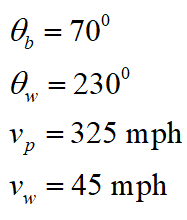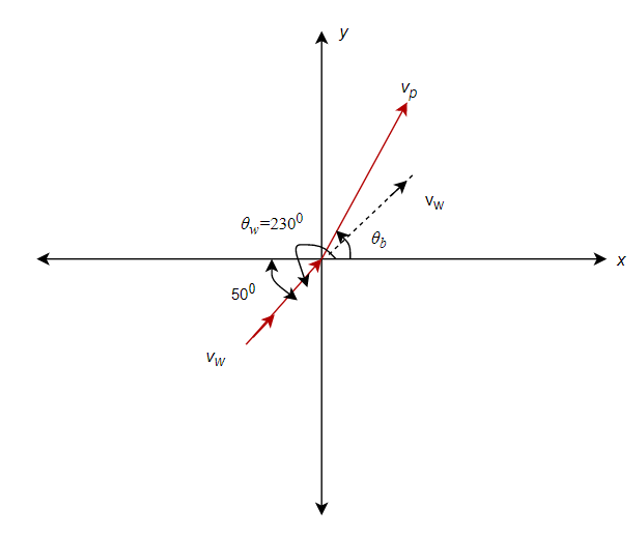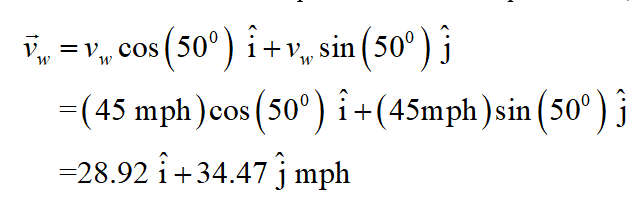10. A pilot wants her bearing to be 70° and her groundspeed to be 325 mph. There is a 45 mph wind blowing from 230°. What bearing should she take? What will her airspeed be? Round the speed to the nearest mph and the bearing to the nearest minute.
10. A pilot wants her bearing to be 70° and her groundspeed to be 325 mph. There is a 45 mph wind blowing from 230°. What bearing should she take? What will her airspeed be? Round the speed to the nearest mph and the bearing to the nearest minute.
College Physics
11th Edition
ISBN:9781305952300
Author:Raymond A. Serway, Chris Vuille
Publisher:Raymond A. Serway, Chris Vuille
Chapter1: Units, Trigonometry. And Vectors
Section: Chapter Questions
Problem 1CQ: Estimate the order of magnitude of the length, in meters, of each of the following; (a) a mouse, (b)...
Related questions
Question

Transcribed Image Text:**Problem 10:**
A pilot wants her bearing to be \(70^\circ\) and her groundspeed to be 325 mph. There is a 45 mph wind blowing from \(230^\circ\). What bearing should she take? What will her airspeed be? Round the speed to the nearest mph and the bearing to the nearest minute.
**Solution:**
To solve this problem, we will utilize vector diagrams and trigonometry to determine the resultant bearing and airspeed of the pilot.
1. **Understanding the Given Data**:
- Desired bearing: \(70^\circ\)
- Groundspeed: 325 mph
- Wind speed: 45 mph
- Wind direction: \(230^\circ\)
2. **Diagram Setup**:
- The direction \(230^\circ\) from north corresponds to approximately south-west. Using vector subtraction, we determine the required course (or airspeed direction) to achieve the desired groundspeed \(70^\circ\).
3. **Vector Calculation using Trigonometry**:
- To solve, we set up the vectors.
- Compute the x and y components of the wind vector.
- Adjust pilot’s course to compensate for wind impact.
4. **Result**:
- **Bearing**: Calculated using the vector addition method and corrected to the nearest minute.
- **Airspeed**: Calculated and rounded to the nearest mph.
This vector calculation involves decomposing the wind and pilot’s velocity vectors into components, applying necessary adjustments, and reforming the resultant vector to find desired parameters.
Expert Solution
Step 1
Given information:

Here, θb and θw are the angles of bearing and wind direction respectively, vp and vw are the speed of the plane and the wind respectively.
Step 2
The situation is represented in the diagram below.

Step 3
The vector vp in the component form can be represented as,
 And the vector vw in the component form can be represented as,
And the vector vw in the component form can be represented as,

Step by step
Solved in 5 steps with 7 images

Knowledge Booster
Learn more about
Need a deep-dive on the concept behind this application? Look no further. Learn more about this topic, physics and related others by exploring similar questions and additional content below.Recommended textbooks for you

College Physics
Physics
ISBN:
9781305952300
Author:
Raymond A. Serway, Chris Vuille
Publisher:
Cengage Learning

University Physics (14th Edition)
Physics
ISBN:
9780133969290
Author:
Hugh D. Young, Roger A. Freedman
Publisher:
PEARSON

Introduction To Quantum Mechanics
Physics
ISBN:
9781107189638
Author:
Griffiths, David J., Schroeter, Darrell F.
Publisher:
Cambridge University Press

College Physics
Physics
ISBN:
9781305952300
Author:
Raymond A. Serway, Chris Vuille
Publisher:
Cengage Learning

University Physics (14th Edition)
Physics
ISBN:
9780133969290
Author:
Hugh D. Young, Roger A. Freedman
Publisher:
PEARSON

Introduction To Quantum Mechanics
Physics
ISBN:
9781107189638
Author:
Griffiths, David J., Schroeter, Darrell F.
Publisher:
Cambridge University Press

Physics for Scientists and Engineers
Physics
ISBN:
9781337553278
Author:
Raymond A. Serway, John W. Jewett
Publisher:
Cengage Learning

Lecture- Tutorials for Introductory Astronomy
Physics
ISBN:
9780321820464
Author:
Edward E. Prather, Tim P. Slater, Jeff P. Adams, Gina Brissenden
Publisher:
Addison-Wesley

College Physics: A Strategic Approach (4th Editio…
Physics
ISBN:
9780134609034
Author:
Randall D. Knight (Professor Emeritus), Brian Jones, Stuart Field
Publisher:
PEARSON